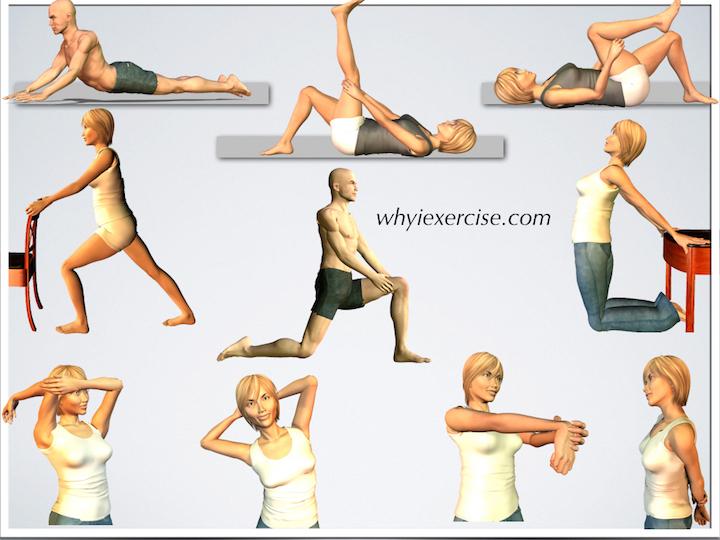In the symphony of movement that defines a workout, each muscle and joint plays its own vital note. Yet, amidst the rhythm of lifting, running, and jumping, there lies an often-overlooked prelude: stretching. This gentle art, a dance of tendons and ligaments, serves as both a preparation and a safeguard, whispering promises of flexibility and resilience. As athletes and fitness enthusiasts alike seek to optimize performance and minimize downtime, the role of stretching in preventing workout injuries emerges as a crucial consideration. This article delves into the science and practice of stretching, exploring how this simple, yet profound, ritual can be the key to unlocking a safer and more effective fitness journey.
Understanding the Science Behind Stretching and Injury Prevention
Stretching plays a pivotal role in enhancing flexibility, which is crucial for reducing the risk of injuries during workouts. When muscles are flexible, they can move through their full range of motion with ease, reducing the strain on joints and tissues. This elasticity helps in absorbing shock and distributing the impact evenly across the body. By incorporating stretching into your routine, you not only improve muscle flexibility but also enhance coordination and balance, which are key factors in maintaining overall body alignment during exercise.
- Improved Blood Flow: Stretching increases circulation, ensuring that muscles receive the oxygen and nutrients they need to function optimally.
- Enhanced Recovery: Post-workout stretching aids in reducing muscle soreness by promoting faster recovery and minimizing stiffness.
- Injury Prevention: Regular stretching helps in identifying and addressing muscle imbalances, reducing the likelihood of strains and sprains.

Exploring Different Types of Stretching Techniques for Optimal Safety
- Static Stretching: This technique involves holding a stretch in a challenging but comfortable position for a period of time, usually between 15 to 60 seconds. It is ideal for cooling down after a workout, as it helps to relax muscles, improve flexibility, and reduce the risk of injury.
- Dynamic Stretching: Unlike static stretching, dynamic stretching involves moving parts of your body through a full range of motion. This type of stretching is excellent for warming up, as it prepares the muscles for action by increasing blood flow and enhancing muscular performance.
- Ballistic Stretching: This method uses the momentum of a moving body or a limb in an attempt to force it beyond its normal range of motion. Although not recommended for everyone due to its potential to cause injury, athletes sometimes use it to improve explosive movements.
- PNF Stretching (Proprioceptive Neuromuscular Facilitation): This advanced form of flexibility training involves both stretching and contracting the targeted muscle group. It is often performed with a partner and is known for rapidly improving flexibility and increasing range of motion.
- Active Isolated Stretching (AIS): In AIS, stretches are held for only two seconds and are repeated several times. This technique is beneficial for increasing circulation to muscle tissues and elongating the muscles without triggering the protective stretch reflex.
Understanding these techniques and incorporating them appropriately into your fitness routine can significantly enhance safety and performance. Each type of stretching has its own set of benefits and is suited to different stages of a workout. By selecting the right method for the right moment, you not only improve flexibility and strength but also minimize the risk of injury, ensuring that your workout remains both effective and safe.

Incorporating Stretching into Your Workout Routine for Maximum Benefit
Stretching often takes a backseat in many fitness routines, yet its importance in injury prevention cannot be overstated. By integrating stretching into your regimen, you not only enhance flexibility but also prepare your muscles for the exertion ahead. When muscles are warm and pliable, they are less prone to strains and tears, which are common culprits of workout-related injuries. Stretching can also improve your range of motion, allowing you to perform exercises with better form and effectiveness.
- Dynamic stretching: Best performed before your workout, these movements, such as leg swings or arm circles, help to gradually increase your heart rate and circulation.
- Static stretching: Ideal post-workout, this involves holding a stretch for 15-60 seconds to help relax the muscles and improve flexibility.
- PNF stretching: A more advanced technique that combines stretching and contracting of the muscles to enhance both flexibility and strength.
Incorporating these types of stretching not only fortifies your body against potential injuries but also contributes to overall muscle health, ensuring that you can maintain a consistent and effective workout routine.

Expert Tips on Effective Stretching Practices to Avoid Injuries
Incorporating proper stretching techniques into your fitness routine is essential for maintaining flexibility and reducing the risk of injuries. Here are some expert tips to help you stretch effectively:
- Warm Up First: Always start with a light warm-up, such as brisk walking or gentle jogging, to increase blood flow to your muscles before stretching.
- Focus on Major Muscle Groups: Pay attention to stretching the primary muscles used in your workout, such as hamstrings, quads, and shoulders, to ensure comprehensive flexibility.
- Hold, Don’t Bounce: Perform static stretches by holding each position for about 15-30 seconds without bouncing to avoid straining the muscles.
- Breathe Deeply: Deep, controlled breaths can enhance your stretch by relaxing your body and allowing you to reach further into the stretch comfortably.
- Listen to Your Body: Stretch to the point of mild tension, not pain. Pushing too hard can lead to injuries rather than preventing them.
By integrating these practices into your regimen, you can enhance your performance and protect your body from unnecessary strain.

